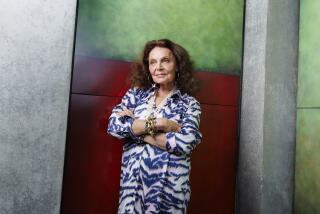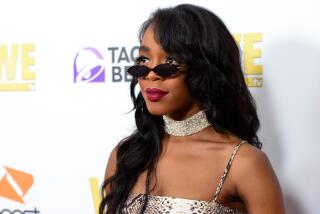‘Grace Kelly: Style Icon’ at the Victoria and Albert Museum
- Share via
London — Twenty-eight years after her death, and more than 50 years after first wowing audiences on the big screen, Grace Kelly, the statuesque blonde with the impossibly small waist and flawless face, continues to inspire designers and admirers alike.
Few celebrities will ever live the sort of life enjoyed by Kelly, who was born in Philadelphia, started her career in the ‘40s as a New York model, came to Hollywood prominence in the ‘50s and later became Her Serene Highness Princess Grace of Monaco. She acquired an Oscar, a prince, a family and the enduring curiosity of a public fascinated with almost every aspect of her life. And for the last few months, that life has been the subject of a retrospective at the Victoria and Albert Museum here.
On display through Sept. 30, “Grace Kelly: Style Icon” features dozens of well-known dresses and accessories, including the black organza pleated day dress she wore in the Alfred Hitchcock classic movie, “Rear Window.”
The exhibit was “a dream come true” for curator Jenny Lister, who spent 18 months assembling a show that has drawn 150,000 visitors since it opened in April.
The exhibit opens with a fairytale-like, strapless pink gown designed by Parisian Maggy Rouff and accented with a sequin-studded net that drapes the gown just below the shoulders. Kelly first wore the gown at her new home — the Princely Palace of Monaco — shortly after wedding Prince Rainier, who at one time was known as Europe’s most eligible bachelor.
The exhibit includes the uncharacteristically floral McCall’s paper-pattern dress Kelly wore when she first met the prince at the Cannes film festival in 1955 (the two wed less than a year later); the Branell polka-dotted shirt dress she wore and the Hermes bag she carried the day their engagement was announced; the Helen Rose lace suit she donned for the civil wedding ceremony; and two of the 40 American-designed dresses that made up her trousseau. Other notable pieces include the pale green Edith Head dress Kelly wore to accept her 1955 Oscar for best actress in “The Country Girl,” as well as the bright green fringed Hubert de Givenchy dress and jacket Kelly wore to meet fellow style icon Jacqueline Kennedy at the White House in 1961.
The garments are accompanied by photographs and film clips that show Kelly wearing them.
While Lister marvels that so many of Kelly’s dresses still exist in pristine form (they have been maintained by the seamstresses to the royal family of Monaco), she adds: “Grace Kelly was very sentimental about her clothes.”
And so, apparently, is the Victoria and Albert Museum, which owns 80,000 costumes and accessories. The Grace Kelly exhibit is placed in the center of its fashion gallery on the first floor — an area that, on a Wednesday morning in July, was teeming with visitors who didn’t balk at the $10 or so they had to pay to view the dozens of designer dresses in this sprawling and otherwise free museum located in London’s South Kensington neighborhood.
Many seemed agog as they wandered the dimly lit but well-organized exhibit that examined the various eras of Kelly’s incredible life — from the Academy Award-winning actress outfitted in plain and pale satins designed by Oleg Cassini and Edith Head, to the enviable bride attired in bedazzled creations from Lanvin, Christian Dior and Hubert de Givenchy, to the princess decked out in flowing chiffons and caftans from Yves Saint Laurent and Madame Gres, many of which were sewn only after Kelly had chosen them from sketches and selected fabric swatches.
As much as the exhibit is a display of classic Kelly style, it’s also a case study of changing tastes from the demure 1950s to the increasingly outré ‘60s and ‘70s. According to Lister, Kelly struggled with the bold styles of the ‘60s.
“She didn’t like showing her knees,” Lister said.
She did, however, like accessories. Kelly’s understated dresses were often accented with unique pieces, and the exhibit showcases many of them in glass cases dedicated to each type. Kelly was known for color coordinating her outfits and eyeglasses — both the horn-rimmed style she needed for reading and the large-lensed sunglasses she donned to shade her blue eyes. Then there are the veiled hats and, of course, tiaras and turbans, as well as the lion and duck brooches she often wore to add a touch of a humor to an outfit.
“Grace Kelly was seen as aloof, a perfect person,” Lister said. “People didn’t realize she had a sense of fun.”
That sense of fun is played up at the end of the exhibit hall, which concludes with a flourish of European designer gowns, most notably from designer Marc Bohan, artistic director of Christian Dior throughout the ‘60s and ‘70s. Kelly was a great patron of Dior and often wore Bohan’s gowns — even elaborate headdresses — to various costume balls.
“Very few people deserve to be called a style icon,” Lister said, “but Grace Kelly is one of them.”






